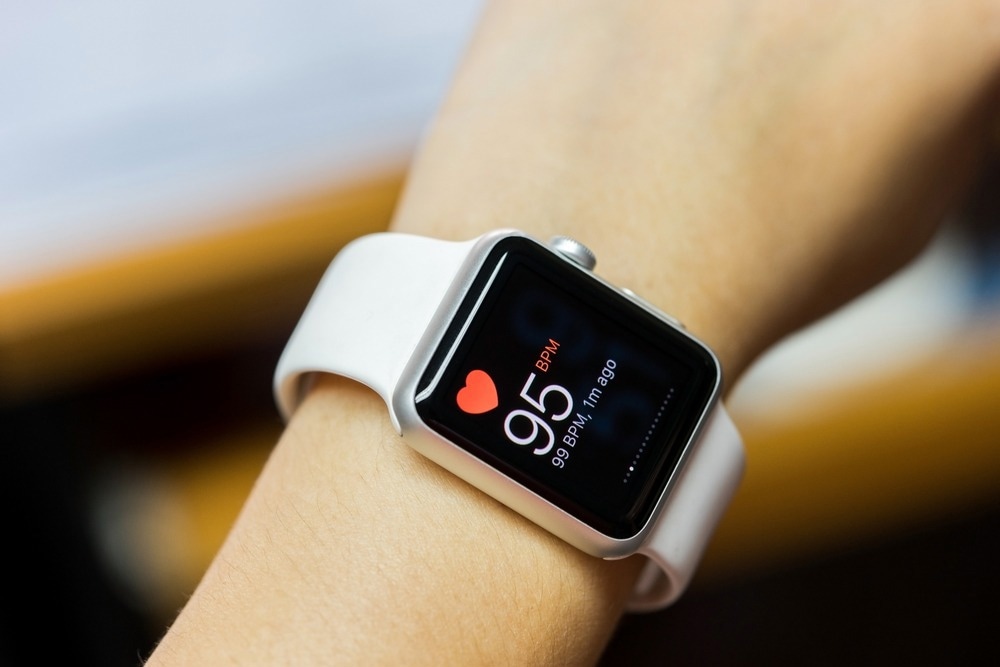Smartwatches include sensors that monitor your health and help users track their fitness in real-time, increasing their popularity. This article will explore the sensors that are used in smartwatches.

Image Credit: BallBall14/Shutterstock.com
Many well-known consumer and medical gadgets are now equipped with wearable sensor technologies.
Smartwatches may give an objective alternative to manage and monitor chronic illness development, such as with the elderly, in rehabilitation, and individuals who suffer from different impairments.
In healthcare, wearable sensors are becoming more popular because of their compact size, high hardware capacity, and cheap cost compared to medical tools that can monitor the same vital signs.
As an added benefit, ambulatory rehabilitation with wearable technology lowers the price tag on more extensive therapy. According to current projections, wearable technology will thrive over the next 25 years, saving the healthcare business a lot of money by reducing clinician/patient contact time significantly.
Different Sensors in Smartwatches
Smartwatches include multiple sensors, several of which are discussed below.
Accelerometer
An accelerometer sensor helps monitor the body's motions by counting daily steps. It monitors sleep patterns, and can even help suggest strategies to improve sleep quality. Such a sensor detects skin resistance to a small dosage of current that the wristwatch transmits over your skin to track parameters like sleeping patterns and heartbeat.
Gyroscope
A gyroscope is a sensor used to measure the orientation and angular rates of the body. When you move your wrist to check your smartwatch, a gyroscope on your wristwatch will notify you in a split second.
By turning off the display when there has not been any movement for a long period, this sensor also helps your smartwatch save battery life.
Magnetometer
A magnetometer is a sensor used to measure magnetic field strength. In smartwatches, it also refers to a compass sensor. This sensor is used to keep track of the motion and direction in which the user is pointing.
Temperature Sensors
There are two types of temperature sensors available in smartwatches. The skin or body temperature sensor is used to measure the amount of heat dissipating from a body after some exertion or workout. It helps monitor the activities that increase the body temperature.
An ambient temperature sensor is used to measure the temperature of the surrounding environment.
Hear Rate Monitor
This sensor keeps track of heartbeats, checking the wearer's pulse for abnormalities. Heart rate sensors in high-end watches can even notify an emergency contact if the user’s heart rate is abnormal.
Skin Conductance Sensor
The galvanic skin response, which refers to any changes that may be detected in perspiration when considering the assertiveness of a person's emotional state, can be calculated by this sensor and aids in determining how many calories were expended during the day.
The electrodes in these smartwatches are sensitive to changes in sweat gland activity and are able to send that information to the smartwatch.
GPS Sensor
In a smartwatch, the global positioning system (GPS) is a sensor that helps track the distance traveled by the wearer when they are jogging, riding, or doing anything else. By synchronizing it with apps on the user's smartphone, the sensor also helps the user reach their location.
Current Challenges
There are currently many challenges and drawbacks associated with the use of smartwatches.
The foremost drawback of using smartwatches is the privacy and security issues of the user, as wearables that monitor health present ethical concerns. The same data that might be beneficial for medical reasons is also lucrative for marketing, and a whole industry of data brokers benefits from selling records obtained via applications and wearables that offer real-time geolocation, activities, and behavioral patterns.
Another drawback is the accuracy of these smartwatches. Most smartwatches lack accuracy, which can lead to serious health concerns. The wrong information by the sensors can risk the health of the smartwatch user.
Significant research is currently being carried out and is needed to improve the accuracy of the sensors, ensure the privacy and security of the user and improve the individual's health by tracking different diseases timely.
Future of Smartwatches
Despite the drawbacks and challenges, the future of smartwatches is quite bright. In the future, smartwatches could be a significant contribution to maintaining well-being, and enhancing patient diagnostic strategies.
References and Further Reading
Kenneth R. Foster, J.T. (2019) ‘The Opportunity and Obstacles for Smartwatches and Wearable Sensors’, IEEE Pulse. Available at: https://www.embs.org/pulse/articles/the-opportunity-and-obstacles-for-smartwatches-and-wearable-sensors/.
O’Donoghue, J. (2021) The science of smartwatches, Royal Society of Chemistry. Available at: https://edu.rsc.org/feature/the-science-of-smartwatches/4013008.article
Tomar, S. (2022) Explained: All Kinds of Sensors in Smartwatche, Pros and Cons. Available at: https://www.cashify.in/explained-sensors-in-smartwatch
Disclaimer: The views expressed here are those of the author expressed in their private capacity and do not necessarily represent the views of AZoM.com Limited T/A AZoNetwork the owner and operator of this website. This disclaimer forms part of the Terms and conditions of use of this website.